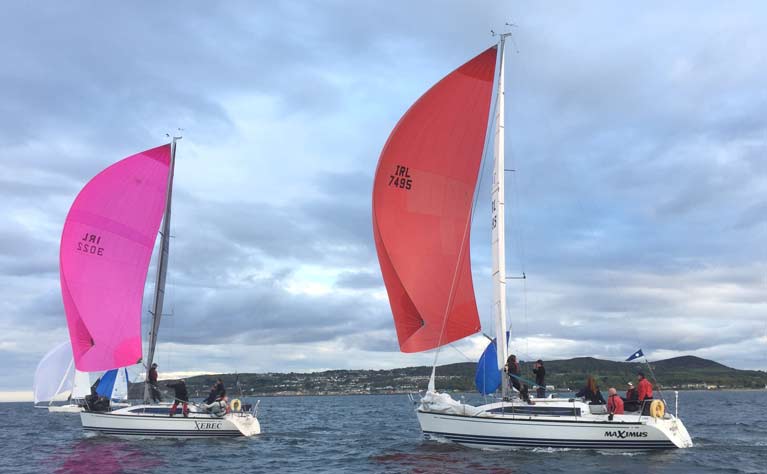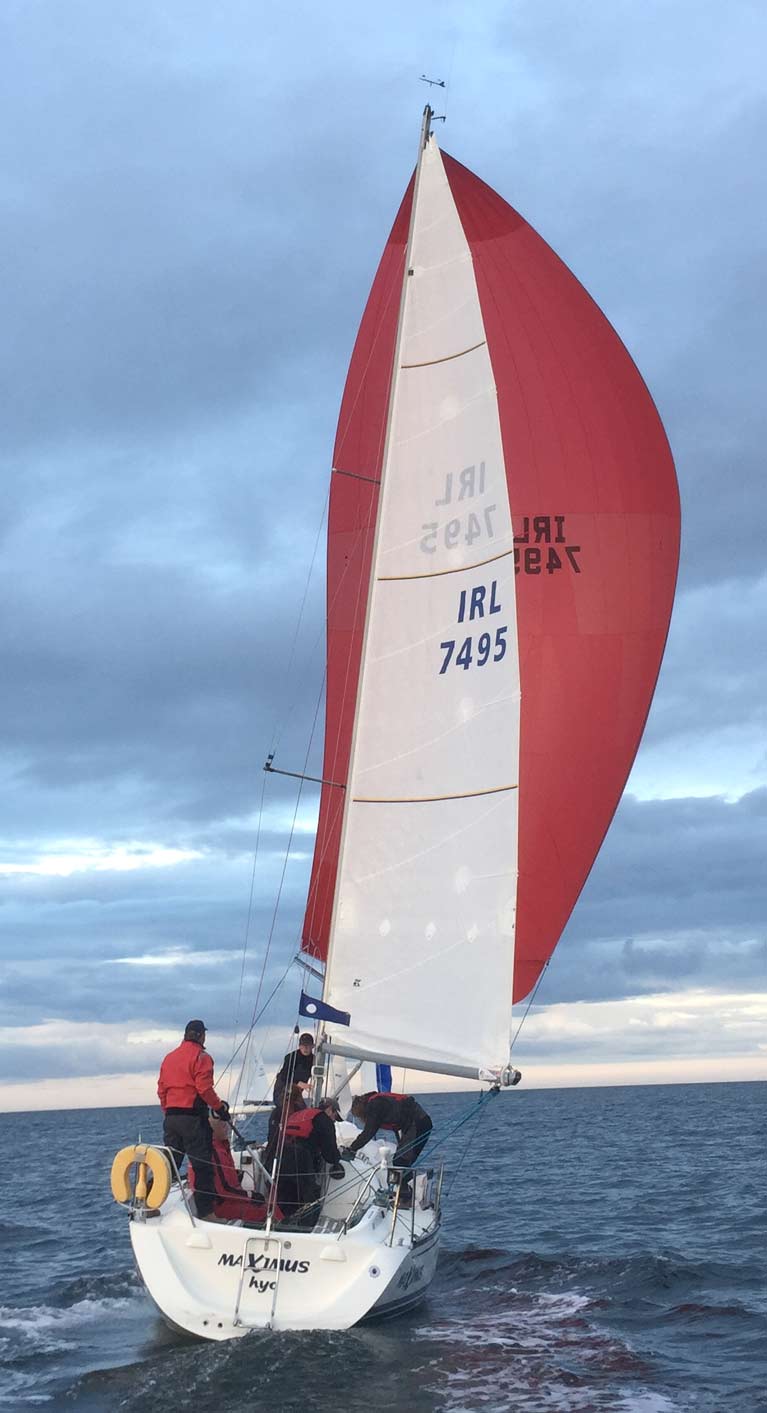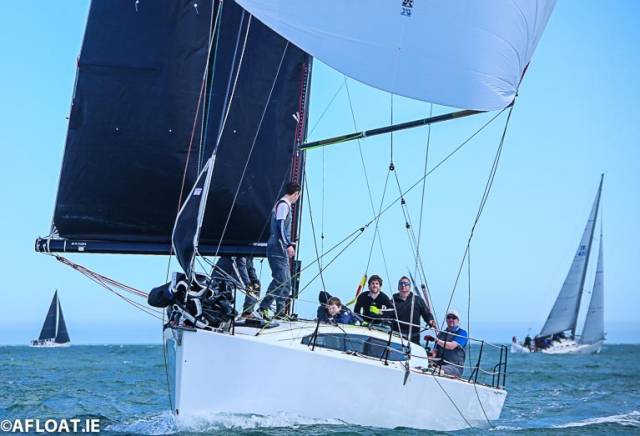May is here and summer is finally upon us (don’t quote me on that) – fleets are hitting race courses throughout the country with renewed enthusiasm after the winter break writes Graham Curran of UK Sailmakers Ireland. Although some fleets have had a busy spring season; the beginning of May is the time where putting foot to deck becomes appealing once again.
Last week Howth Yacht Club began their midweek evening series which runs throughout the season – always well attended with the first race being no exception. With it being the first day afloat for many in quite a while, certainly in a competitive context, everyone can be forgiven for being a little rusty.
I spotted many opportunities for improvement both at a fundamental trim level but also at minor tweaking level, but one thing stood out to me – the use of spinnaker tweakers.
WHAT ARE YOUR TWEAKERS FOR?
Fundamentally your tweakers serve the same purpose for your spinnaker as your jib cars do for your headsail, or as the vang does for your mainsail – they control the amount of twist in your spinnaker. They are, of course, not the only twist control – that would be far too easy!
Many of us think of the tweakers as something that needs to be pulled on when gybing our spinnakers, pulled on full on the side that the pole is on, and left off completely on the sheet. Although this is not entirely incorrect; it is far too basic an explanation. Your tweakers deserve more than that. They are the unsung heroes of downwind sail trim.
DEEP DOWNWIND
Deep downwind sailing is where tweakers become essential trim tools – so we’ll start here.
Last week the usual X302 battle between “Maximus” and “Xebec” picked up where it left off. Tit for tat around the racecourse both crews were warming up nicely for their season ahead. From the rib to leeward I immediately noticed the tweaker position on “Xebec” – and a perfect photo opportunity.

Let’s look at each boat’s setup – focusing on tweaker trim.
Maximus is nicely squared away with her spinnaker projected to windward. Her tweaker is on about 25 (with 0 being the deck and 100 being fully off). Both clews are level. The leech of her spinnaker (attached to the sheet) is nicely closed and of a very similar profile to the luff of the sail (attached to the pole) ie the sail is set symmetrically. If we were to look at Maximus’ spinnaker from directly behind it would be standing broad – its shoulders projecting outwards to maximize its area – and containing all the power it can inside the sail. Think of a boxer in stance with two strong arms (the leech and the luff) ready to strike.
If we now look at Xebec and compare. Her pole is squared back to the same degree (both could come a little further but we’ll forgive that!), pole height is the same. The luff, supported by the pole, is standing broad and proud, nicely projected to windward. Her tweaker however is at 100, completely off. The leech of the sail is twisted open and the clews are not level, with the sheet clew being higher. Xebec is spilling power out of the leech – not maximising the wind available. Back to our boxer analogy – they are the injured opponent with a limp left arm.
This effect of this spilling off the leech is only accentuated as the wind speed increases.
WHAT IS MY INDICATOR OF GOOD TRIM?
The short answer is to ensure the clews of the spinnaker are level. The complicated answer is that good tweaker trim is entirely reliant on the other elements of spinnaker trimming. The tweaker is generally the last in the line of adjustments, which is why it is sometimes forgotten about. Trimming for curl, pole height, and pole fore and aft trim are all set before the tweaker trim can really be determined. The fore and aft pole trim and the tweaker are particularly interrelated as the boat changes angle and point of sail.
In general, though you can’t go far wrong by keeping the clews level.
LEVELS OF ADJUSTMENT
Tweakers are not an all or nothing tool, but they also do not need to be trimmed to the millimetre. I use a system with five stages of trim. 0, 25, 50, 75, and 100.
• 0 or “full on” – tweaker pulled down fully to the deck. If using only two sheets (no lazys) the guy (pole) will always be on full.
• 25 – to the lower guard rail.
• 50 – to the upper guard rail.
• 75 – mid way between the upper guard rail and the boom.
• 100 or “full off” – tweaker blown and loose.
Having these levels makes it very easy to change between settings and keeps everyone on the same page. It is very hard to give concrete setting for each wind speed as it is entirely subjective to each boat and each sail design. Experiment with different levels and keep an eye on your clew heights and you will soon find what works best for you in each band of wind speed.
REACHING
Our tweaker trim completely changes when we move from running to reaching. The theoretical reason for this is that when running we are harnessing and encouraging vertical flow in our spinnakers, from the head down and out the foot of the sail – dragging us downwind. When we move to reaching we are harnessing horizontal flow across the sail, from luff to leech. We want the wind to enter at the luff, produce power to drive us forward as it passes over the sail, and then to exit the leech with as little friction as possible.

Maximus, now broad reaching, still has her tweaker pulled on full. Considering the wind strength on the evening it is not a major issue. The tweaker is still doing the same job here – reducing the amount of twist in the spinnaker leech.
If Maximus were to come up on a tight reach, or if the wind speed was to increase to 16-17 knots, she would quickly become slow and overpressed with the tweaker on fully.
When reaching you need twist in the leech of the spinnaker. Eventually, as you sheet harder or the wind increases, the leech will begin to close and stall. Instead of the wind escaping out the leech of the sail it will encounter too much resistance, slowing the boat as a result. A closed leech while reaching will use the power in the wind to heel the boat over, instead of pushing it forward – not fast. The heel will cause weather helm, so more rudder will be needed to keep the boat on course. More rudder means more resistance which means slower boat speed. This can eventually lead to broaching in heavier wind speeds.
So as you transition from running to broad reaching to tight reaching, gradually ease your tweaker off as required to keep the boat pushing forward, not dragging sideways.
GYBING
This is where most of us notice our tweakers – but why?
When we are gybing the spinnaker, for a period of time, is free of the pole – floating. It is attached to the boat at the head and the two clews.
If both our tweakers are off at this stage the spinnaker will tend to rise. This, in essence, twists both the leech and the luff of the sail, making it unstable and liable to move from side to side. By pulling on our tweakers fully we “lock down” the spinnaker to the boat. The clews are not allowed to rise, the luff and leech do not twist as much, and the spinnaker becomes far more stable.
It is particularly obvious when one tweaker is on and the other is off – the spinnaker will roll to the side with the tweaker on as that is where the power is. Because we are gybing the spinnaker will then end up on the wrong side, behind the mainsail, liable to collapse, and will be putting pressure on the bow person who is trying to push out the poll.
This is not as critical in lighter airs when the wind does not have the power to lift the spinnaker high into the air, but in moderate and heavy airs it is critical for a controlled gybe.
Once you have exited the gybe and are settled on your new course you can then gradually ease the tweaker while continuing to trim the sheet.
CONCLUSION
As with many things in sailing; there is far more to tweakers than you might initially think. If you are looking to maximize your downwind performance then they should be given thought but, as always, look for the big trim gains first – then tweak for peak performance.




























































